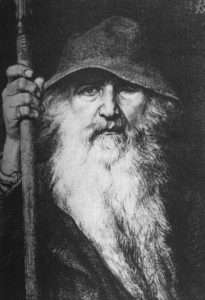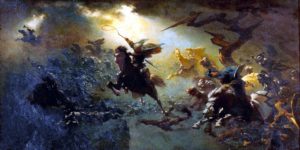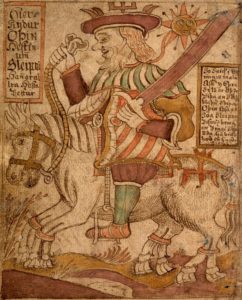
Yule celebrations are Pagan in origin and came from the Germanic countries. They were alive and well in the Nordic lands, and were most likely brought over to Anglo-Saxon England with the Viking settlers. Eventually, the midwinter celebrations merged with the Christian festival of Christmastide, better known as the 12 Days of Christmas. I think we would recognize many of their festivities, although some of them were dedicated to Odin!
Since the Yule (or Jul) took place around the Solstice, the shortest day of the year, there is a certain element of celebrating the return of the light. It is said that the name Yule is derived from the Old Norse HJOL, meaning ‘wheel,’ to identify the moment when the wheel of the year is at its lowest point, ready to rise again. But it was also thought that in this time of year, the spirits of the dead most commonly crossed over into the human realm. It is thought that many of the Yuletide customs were an attempt to protect the household against hostile supernatural influences. On the other hand, it is also said that ancestors came back during this season, and sometimes food was left out for them so they would help promote a good harvest the following year. Some of the spirits were benevolent—but not all.
One night stood out from the others—the 24th of December. This is when the children filled their shoes with straw, carrots and sugar lumps and set them out by the fire to feed Odin’s flying eight-legged horse Sleipnir as the God led the Wild Hunt—the host of the restless dead—through the darkness. In return, Odin would leave the children small gifts and sweets as a reward. He was even known to slide down the chimney! Or fire hole, as the case may be.

Many tales were told of the Wild Hunt. Because winter nights were often stormy and turbulent, Odin was most likely to be heard then, raging and howling, riding to collect the fallen, whether they be living or recently departed. People—especially children—were warned to stay indoors. It was a terrible thing to witness the Wild Hunt; rumors abounded that people seeing the Wild Hunt might be abducted to the underworld or to the fairy kingdom—or even killed. A gift—or rather, a sacrifice—was advised, to thank Odin for taking care of the family’s recently deceased. In 1673, Johannes Scheffer (The History of Lapland) wrote “All the Bits they have preserved for these two Days, they put in a small Chest made of the Bark of Birch, in the shape of a Boat, with its Sails and Oars; they pour also some of the Fat of the Broth upon it, and thus hang it on a Tree, about a Bow Shot distant from the backside of their Huts”. Perhaps this represented the practice of ship burials, though no one really knows the exact purpose of this ritual.
Yule is a time for feasting, dancing, and family. The traditional food of the Yule was Boar, an animal sacred to Freyr, the Norse God of Yule and fertility. This was probably the origin of the Boar’s Head presented at later Christmas feasts. Then we have the Yule Log. The largest ash—the wood of Yggdrasil—log was brought inside so that ritual runes could be carved onto it, calling on the gods to protect one and all from ill-fortune. Burning the Yule log was thought to give power to the sun and bring warmth again to the land. The carved log was sprinkled with mead and decorated with dry sprigs of pine and cones and as it was lit, musicians plucked the strings of their harps and started the singing. It burned for twelve hours, which brought good fortune for the next twelve months.

Outside, evergreens would be decorated with small lanterns and candles, plus crackers, little carved statues of gods, pieces of dried fruit, and even berries strung together. A huge bonfire was lit, reportedly to dispel any evil that was marching abroad. There was dancing around and through the bonfire, especially among the youngsters.
It’s pretty commonly assumed that Odin the Wanderer eventually morphed into our Santa Claus. The old legends came in many forms, one of which was Odin on a chariot pulled by goats (who later became reindeers). Or, possibly, his eight-legged Sleipnir was the precursor to reindeer (naturally, from the North). Odin who was the lord of Alfheim, the home of the elves (Santa’s elves?). The comparisons go on and on. How much of is true?
Mike@Bitaboutbritain says:
Excellent. I’m fascinated by where our traditions may come from.